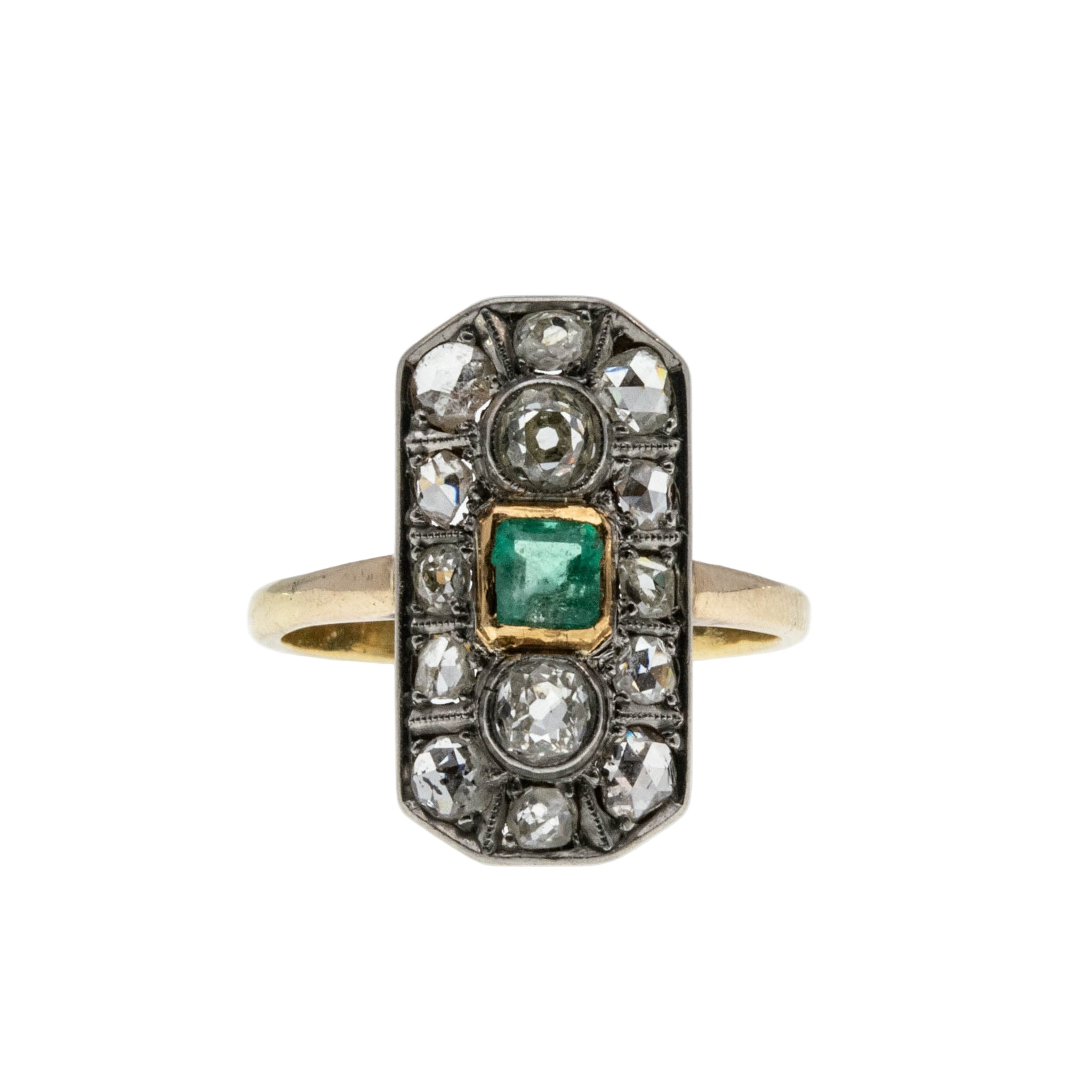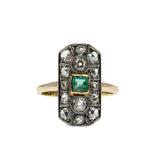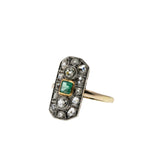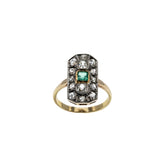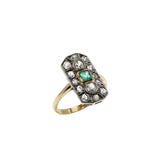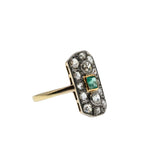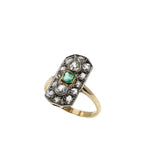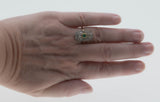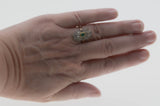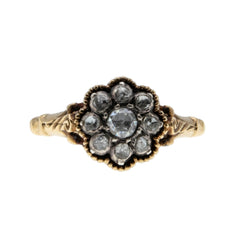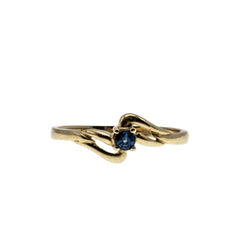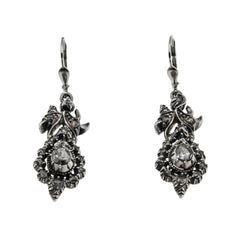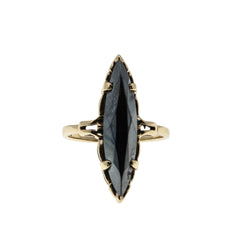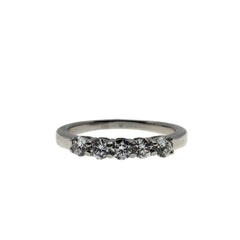Garden of Versailles - Victorian French 14K Gold Natural Emerald 'Old Mine Cut Diamond' & Rose Cut Diamond Ring (VICR179)
Rarities Antique Jewelry
Garden of Versailles - Victorian French 14K Gold Natural Emerald 'Old Mine Cut Diamond' & 'Rose Cut' Diamond Ring. This exquisite time is crafted from 14K yellow, and white gold, tested. The ring features one natural square cut emerald, 2 natural 'Old Mine Cut' diamonds, 12 natural 'Rose Cut' diamonds, Victorian era styling, and quality craftsmanship. The gallery on this special ring is adorned by a beautiful bezel-set green emerald, which is surrounded by glowing old mine cut and rose cut diamonds. The band is crafted in yellow gold, and is smooth and polished, which allows for a comfortable fit, and easy sizing. The ring is a beautiful Victorian era example, which looks stunning when worn. Truly a treasure to be cherished for many years to come.
Comments: Rare piece. Featuring beautiful hand-cut antique diamonds, and a natural emerald. Lovely example of Victorian era jewelry.
Note: Contemporary appraisals do not reflect the value of antique jewelry. It is highly recommended that this Victorian era emerald and diamond ring be insured for $7000.00 CD (Tax Excluded)
History: The earliest diamonds were found in India in 4th century BC, although the youngest of these deposits were formed 900 million years ago. A majority of these early stones were transported along the network of trade routes that connected India and China, commonly known as the Silk Road.
The rose cut originated in the 1500's and was commonly used through the Georgian and Victorian eras. Like other antique diamond cuts, they were cut by hand and meant to dazzle under candlelight. Their large, wide facets performed exquisitely in low light conditions.
The rose cut is considered to be one of the oldest diamond cuts. Rose cut diamonds gathered popularity from their creation in the 1500s right through to the late 19th Century.
You cannot look at rose cut diamond jewelry factually with a recut formula in mind, its value is object driven. Rose cuts are a greater challenge in estimating weight once they have been mounted (especially if they are closed back). These rose cut diamonds are hand cut, which makes them so special . This is a rare find.
The rose cut diamond is closed back ( a characteristic of Georgian and early Victorian jewelry). Closed back jewelry should never be immersed in liquid. To clean, wipe the ring gently with a damp (not saturated) cloth with warm water, and pat dry with soft cloth.
Today, they are seeing a renaissance and are highly sought-after.It can be challenging to find a rose cut that you'll love because they are so rare in the market. - Because the rose cut diamond is cut by hand, there will often be tiny imperfections or asymmetries to the facets.
Many are already aware of history behind the 'ring finger,' and with the romanticism of the 'Rose Cut', the cut became a symbol for love as the ring would be “wrapped around the part of the body that connected directly to the heart”
The Old Mine Cut diamond, a historical style of diamond cutting, gained popularity in the late 18th centuries, particularly during the Georgian, Victorian, and Edwardian eras. Originally used to describe diamonds from older mines in Brazil and India, the term eventually encompassed any diamond cut in a similar squarish shape with a high crown, small table, and large culet. These diamonds were hand-cut and known for their unique, often asymmetrical, facets, which produced a softer, more subtle brilliance than modern cuts.
You cannot look at Old Mine Cut diamonds with a formula in mind, its value is object driven. They are a greater challenge in estimating weight once they have been mounted (especially if they are closed back). The Old Mine Cut diamonds are hand cut, which makes them so special .
In 1953, GIA formally created its diamond grading system, known as the 4 C's. The 4 Cs of diamond quality are the universally recognized diamond grading system still to be used today. 1n 1955, GIA presented its first diamond grading reports, which became the hallmark of grading reports in the diamond industry. Before this time in antiquity clients did not care about diamond grading. It was based more so on the size of the diamonds (according to budget) , style, and sentiment. This ring is a wonderful example of the Art Deco era, just beautiful!
Emerald gemstones were mined in Egypt as early as 330 BC, but some estimate that the oldest emeralds are 2.97 billion years old. Cleopatra is perhaps the most famous historical figure to cherish emerald gemstones.
Gold was generally used for a couple thousand years solely to create things such as jewelry and idols for worship. This was until around 1500 BC when the ancient empire of Egypt, which benefited greatly from its gold-bearing region, Nubia, made gold the first official medium of exchange for international trade.
White gold emerged in the 20th century as a popular alternative to platinum, initially driven by its affordability and similar aesthetic appeal. While platinum was expensive and sometimes scarce, white gold offered a more accessible option while still providing a luxurious look, particularly for engagement rings and wedding bands. Its rise in popularity also coincided with the Edwardian and Art Deco movement, where its sleek, modern design complemented the era's aesthetics.
Measurements: Face of the Ring 20.00 mm x 10.50 mm
Stone Size: Emerald .36 carats Diamonds (Old Mine Cut) .60 carats Clarity SI1 Colour G Diamond (Rose Cut) 1.02 carats. Clarity SI1 Colour G-J Total Diamond Weight: 1.62 carats
Weight: 3.95 grams
Ring Size: 8 1/2
Condition: Excellent
Origin: France
Date: Circa 1890

